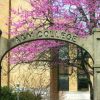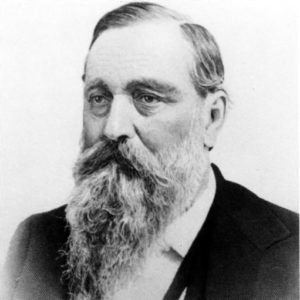calsfoundation@cals.org
Roscoe Greene Jennings (1833–1899)
Roscoe Greene Jennings was one of the eight founders of the Arkansas Industrial University Medical Department, now the University of Arkansas for Medical Sciences (UAMS).
Roscoe Jennings was born in Leeds, Maine, on June 11, 1833, the fourth son and fifth child of Perez Smith Jennings and Johanna (Lane) Jennings. His great grandfather, Samuel Jennings of Salem, Massachusetts, had held an important office under King George III of Great Britain but, after the Revolutionary War, had lost his property and moved to Maine to farm. Young Roscoe grew up working on a farm there in the summer and attended school during the winter. He later traveled and taught school to support himself and his continuing education. Jennings apprenticed in medicine with Alonzo Garcelon, later governor of Maine, in Lewiston, Maine. Jennings attended Dartmouth Medical College and the Medical School of Maine, from which he graduated with honors in 1856.
Jennings practiced medicine for a short time in Lapeer, Michigan, having come there at the invitation of a distant relative. Toward the end of 1857, he traveled by steamboat and stagecoach through New Orleans to Washington (Hempstead County), where his eldest brother, Orville, a lawyer and later U.S. district attorney, lived. He entered the Confederate army as surgeon with the rank of major of the Twelfth Arkansas Infantry Regiment. He was involved in the Battle of New Madrid and was sent to Helena (Phillips County) and Vicksburg, Mississippi, to establish Confederate hospitals. He resigned his commission in 1864 and moved to Little Rock (Pulaski County), where he was involved with a number of United States Army hospitals. With the end of the war, Jennings established a private practice in Little Rock.
Jennings married Gertrude Elliot of Camden (Ouachita County) on April 10, 1869, at the U.S. Arsenal located in what is now MacArthur Park in Little Rock. The couple had three children—a daughter and two sons.
In 1874, during the Brooks-Baxter War, Jennings sided with Governor Elisha Baxter and was appointed by the governor as surgeon general of the Arkansas troops. With the cessation of the war and Baxter’s recognition by President Ulysses S. Grant as the legitimate governor of Arkansas, Jennings was never mustered out of service and thus remained Arkansas’s surgeon general for the rest of his life.
Jennings joined his friend Philo O. Hooper and six colleagues to establish the Medical Department of Arkansas Industrial University—now the University of Arkansas for Medical Sciences—in 1879. A powerful and articulate speaker, Jennings served the new medical school as secretary until 1893. His secretarial duties seemingly included overseeing the finances of the new school based on his reports to the stockholders. Additionally, Jennings helped to establish necessary contacts with the appropriate national groups, including the American Medical Association (AMA). Besides his administrative duties, Jennings served as Professor of Clinical Surgery and Venereal Diseases and Dermatology, a position he held until 1898.
Jennings died on April 5, 1899, of pneumonia. He was cremated, and his remains are buried in the mausoleum at Mount Holly Cemetery in Little Rock.
For additional information:
Baird, W. David. Medical Education in Arkansas 1879–1978. Memphis: Memphis State University Press, 1979.
Clatworthy, Mary Catherine. “Dr. Roscoe Jennings: Influence on Students Then and Now.” MA thesis, University of Arkansas at Little Rock, 2020.
Biographical and Historical Memoirs of Pulaski, Jefferson, Lonoke, Faulkner, Grant, Saline, Perry, Garland and Hot Springs Counties, Arkansas. Easley, SC: Southern Historical Press, 1978.
Nolte, Eugene A. “Downeasters in Arkansas: Letters of Roscoe G. Jennings to his Brother.” Arkansas Historical Quarterly 18 (Spring 1959): 3–25.
Max L. Baker
University of Arkansas for Medical Sciences
 Education, Higher
Education, Higher Health and Medicine
Health and Medicine Post-Reconstruction through the Gilded Age, 1875 through 1900
Post-Reconstruction through the Gilded Age, 1875 through 1900 Roscoe Jennings
Roscoe Jennings 




Comments
No comments on this entry yet.